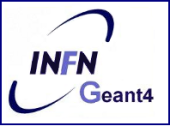Speaker
Francesca Renzi
(MAPrad s.r.l)
Description
This work presents the features of a monitoring system developed for radiation hardness studies on electronics components and systems at Superconducting Cyclotron at INFN-LNS (Istituto Nazionale di Fisica Nucleare, Laboratori Nazionali del Sud, Catania, Italy). Relevant beam parameters as flux, 3-D beam profile and energy are measured with high accuracy with double sided 1.5 mm thick microstrip silicon detector which act as calorimeter. All monitoring setup is fully automatic to perform Single Event Effects studies with heavy ions. In this study gaseous ions Ne20, Ar40, Kr84 and Xe129 with 20 MeV/n energy are used.
The operation in air, which means less complication in test setup and faster execution times provides also the advantage of using the air thickness in front of Device Under Test (DUT) as degrader hence to fine tune the energy values available at the DUT surface.
A careful evaluation of energy loss in air and of the energy spread at DUT surface is carried out through a full Monte Carlo simulation of test setup and comparing the results with data.
The results of careful investigations for beam flux uniformity in space and time as well as effects of fragmentation which may happen in air are also discussed.
We have exposed during the same session, two beam calibration systems, the "Reference SEU monitor" developed by ESA/ESTEC and the beam monitoring and dosimetry setup developed by our group. The results are compared and discussed here.
Keymords
Radiation effects, radiation test, dosimetry, heavy ion accelerators, Linear Energy Transfer, Monte Carlo simulation
Summary
We have developed a fully automatic dosimetry system to demonstrate the validity of beam characteristics of LNS sites for SEE and DD tests. Therefore, a Geant4 code has been created to observe the contribution of fragmentations, which may be produced in air, into total ionizing energy deposition and LET values for DUT, and to calculate the range in DUT.
| Are you a Memeber of the Geant4 Collaboration (yes/no) | no |
|---|
Primary authors
Andrea Papi
(INFN Perugia)
Behcet Alpat
(INFN Perugia)
Dario Vazzana
(MAPrad s.r.l)
Diego Caraffini
(MAPrad s.r.l)
Ercan Pilicer
(INFN Perugia)
Fabrizio Bizzarri
(MAPrad s.r.l)
Francesca Renzi
(MAPrad s.r.l)
Haluk Denizli
(Abant Izzet Baysal University Turkey)
Marco Petasecca
(MAPrad s.r.l)
Mauro Menichelli
(INFN Perugia)
Postolache Vasile
(MAPrad s.r.l)
Co-authors
Francesco Ferrera
(Laboratori Nazionali del Sud INFN)
Marcello Lattauda
(Laboratori Nazionali del Sud INFN)
Pablo Cirrone
(Laboratori Nazionali del Sud INFN)
Paolo Finocchiaro
(Laboratori Nazionali del Sud INFN)
Pierpaolo Figuera
(Laboratori Nazionali del Sud INFN)




